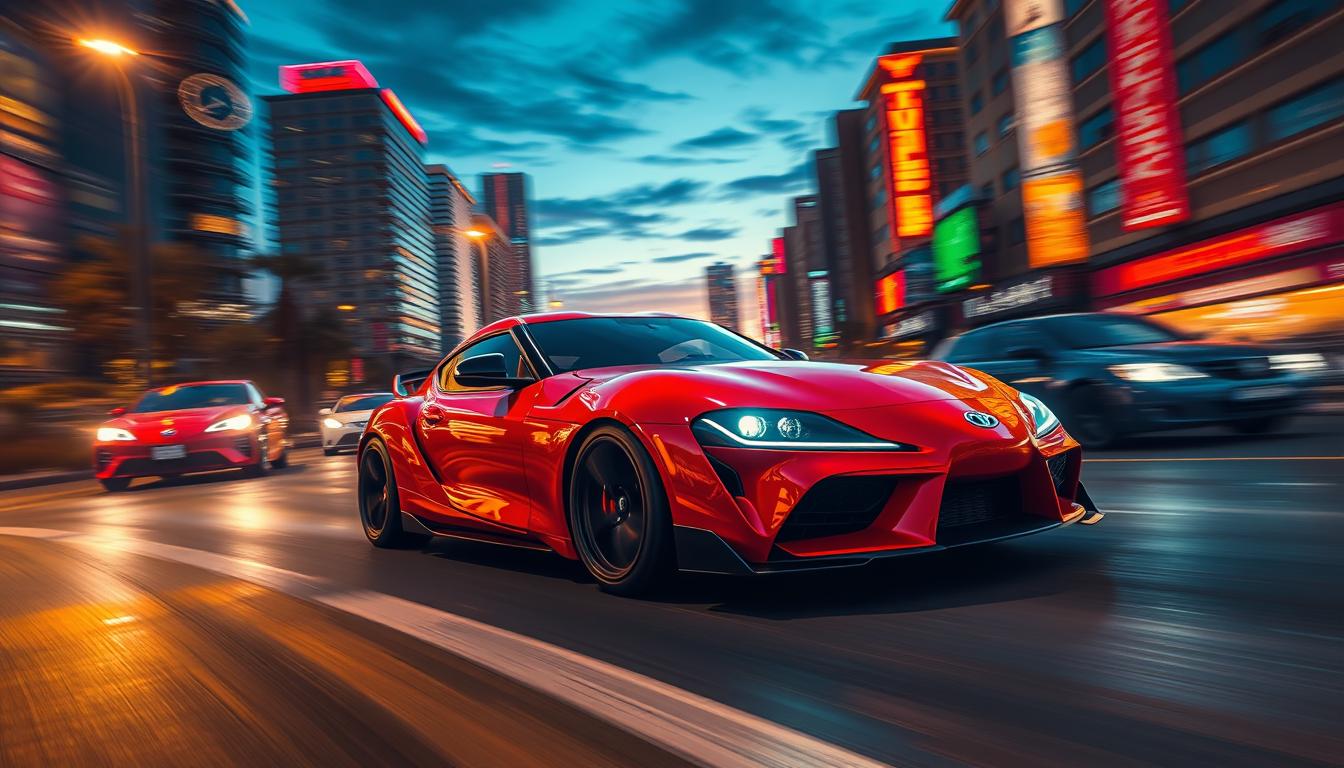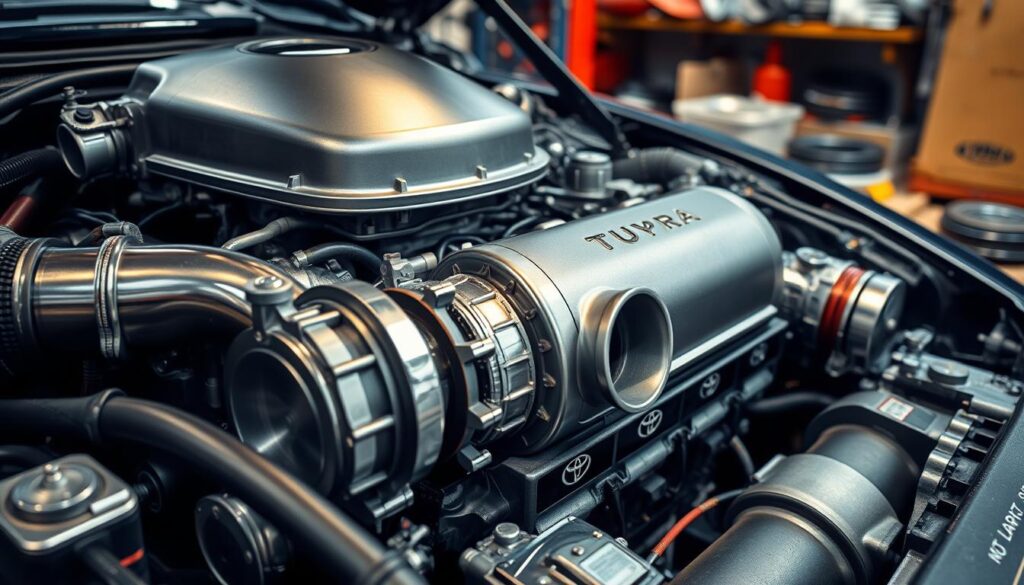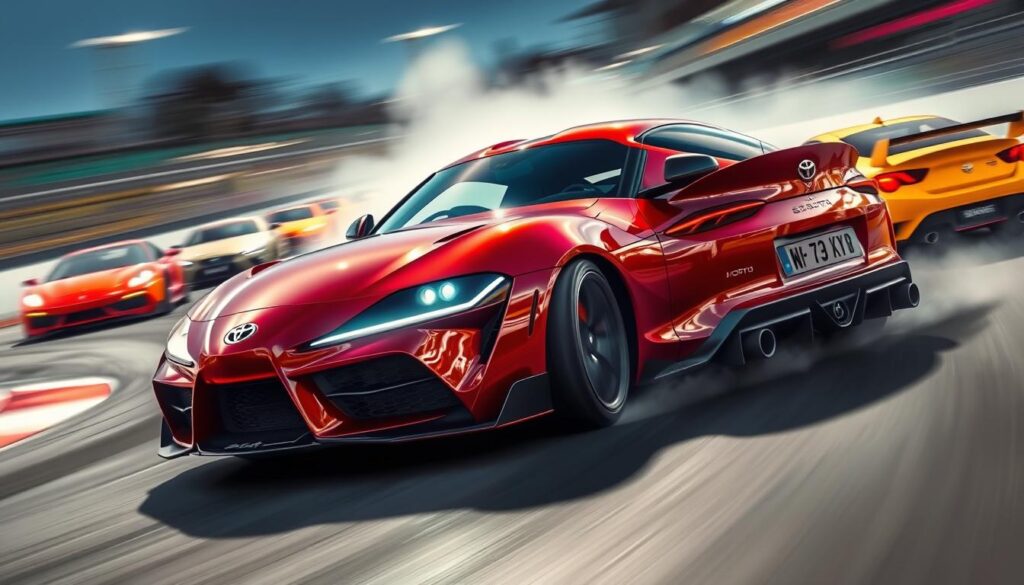
What makes the Toyota Supra stand out as a legendary sports car1? It has a rich history over five generations. This car has won hearts with its advanced tech, strong engines, and eye-catching design. It started as a bigger version of the Celica and now stands as a top sports car on its own.
Toyota’s dedication to innovation and quality is shown in the Supra’s journey. It’s a story of how a car can evolve and still keep its charm and power.
Key Takeaways
- The Toyota Supra has evolved from a Celica variant to a standalone sports car model over five generations.
- The Supra is known for its powerful engines, including a 3.0-liter turbocharged straight-six with 382 horsepower and 368 lb-ft of torque.
- The latest Supra model boasts impressive performance, with a 0-60 mph time as low as 3.9 seconds and a top speed of 155 mph.
- The Supra’s design and engineering have consistently pushed the boundaries of sports car performance and innovation.
- The Supra’s racing heritage and cultural impact have made it a legendary icon in the automotive world.
Evolution of an Icon: From Celica to Superstar
The Toyota Supra’s journey is truly captivating. It started in 1978 with the A40 Supra, a Celica variant. But it quickly found its own unique identity2. The A60 model in 1981 kept its ties to the Celica but stood out with its design and performance.
The Birth of a Legend: First Generation Origins
The A70 Supra in 1986 marked the model’s true independence. It had a more powerful engine and a sleek exterior. This hinted at its true sports car nature2. The 1990s A80 Supra solidified its legendary status with its turbocharged engine.
Breaking Free: Independent Identity
The Supra returned in 2019 with the A90 model, made in partnership with BMW2. This new model combined German engineering with Toyota’s sports car heritage. It was a blend of performance and pedigree.
Modern Renaissance: The BMW Partnership
The Supra’s evolution shows its unwavering spirit. Each generation added to its rich history and reputation. From its Celica roots to becoming a global sports car icon, it has captivated many.
| Generation | Production Years | Engine | Notable Features |
|---|---|---|---|
| A40 | 1978-1981 | 2.6L Inline-6 | Celica-based variant |
| A60 | 1981-1986 | 2.8L Inline-6 | Distinctive Supra identity |
| A70 | 1986-1993 | 3.0L Inline-6 | Independent from Celica |
| A80 | 1993-2002 | 3.0L Turbo Inline-6 (2JZ-GTE) | Legendary performance and tuning |
| A90 | 2019-present | 3.0L Turbo Inline-6 | BMW partnership, modern revival |
“The Toyota Supra’s evolution has been a captivating journey, transforming from a Celica-based model to a globally recognized sports car icon.”
The Toyota Supra’s rich history and unique identity have made it a beloved figure in the automotive world2. From its humble beginnings to its modern renaissance, the Supra’s legacy continues to inspire and leave a lasting mark on the sports car landscape.
The Heart of the Beast: Toyota Supra Powertrains

The Toyota Supra’s powertrains have made it a legend. Early models had inline-six engines, evolving to the famous JZ-series. The 2JZ-GTE engine in the fourth-generation Supra is legendary for its tuning potential3.
The A90 Supra models keep the straight-six tradition but with a twist. They use BMW’s B58 inline-six engines. Engine power has grown from 110 horsepower to over 380 horsepower in the latest models. Aftermarket tuning can make these numbers even higher4.
| Model | Engine | Horsepower | Torque | Acceleration (0-60 mph) | Top Speed |
|---|---|---|---|---|---|
| Supra GR 550 | Tuned 2JZ-GTE | 550 hp | 567 lb-ft | N/A | N/A |
| A90 Supra 2.0L | 2.0L BMW B48 | 255 hp | 295 lb-ft | 5.0 seconds | 155 mph |
| A90 Supra 3.0L | 3.0L BMW B58 | 382 hp | 368 lb-ft | 3.9 seconds | 155 mph |
| A90 Supra 45th Anniversary Edition | 3.0L BMW B58 | 382 hp | 368 lb-ft | 3.9 seconds | 155 mph |
The Supra GR 550 has a tuned 2JZ-GTE engine, making 550 horsepower and 567 lb-ft of torque. This is more than the standard 340 horsepower and 368 lb-ft3. Upgrades include a turbocharger, radiator kit, and carbon intake3. A special exhaust system adds to the car’s sound3.
MANHART has made the Supra GR 550 look amazing. It has Concave One rims and a carbon fiber body kit3. You can get more details on this special Supra from MANHART3.
The Toyota Supra’s powertrains have made it a sports car icon. From the 2JZ-GTE to the modern BMW engines, the Supra’s heart beats with performance and tuning potential. It captivates car lovers and driving enthusiasts everywhere.
Toyota Supra Performance and Engineering Excellence
The Toyota Supra is known for more than just its strong engines. The Supra lineage is deeply rooted in motorsport and performance excellence5. This shows a long history of top-notch performance. The latest model has a strong chassis, perfect weight balance, and advanced aerodynamics. These features make it handle well and ready for the track5.
Chassis and Suspension Mastery
The Supra’s chassis and suspension are designed for precise handling. The Supra is equipped with BMW M firepower, suggesting a collaboration between Toyota and BMW to optimize performance.5 The Toyota Electronically Modulated Suspension (TEMS) has been used in many Supra models. It offers both comfort and agility5.
Track-Ready Capabilities
The Toyota Supra GRMN is designed to deliver an exhilarating driving experience, with fast acceleration and sharp handling5. Anticipation for the Toyota Supra GRMN is steadily increasing as spy shots surface, showing a lot of interest from car fans5.
Advanced Driver Technologies
Modern Toyota Supras come with the latest driver technologies. The 2020 GR Supra has features like automated emergency braking, lane departure warning, and forward collision warning.6 These systems help the driver stay in control, making the drive better.
Rumors suggest the development of a hybrid or all-electric Supra in the future, showing Toyota’s dedication to innovation and the Supra’s evolution7.
“The upcoming Toyota Supra GRMN is expected to redefine high-performance sports cars, indicating a drive towards innovation and pushing the boundaries of automotive engineering.”
Cultural Impact and Racing Heritage

The Toyota Supra has made a lasting impact on car culture, especially in motorsports and tuning8. It was first introduced in 1978 as a high-performance version of the Toyota Celica8. The second-generation model quickly became a symbol of performance8.
The third-generation Supra, known as the MK3, gained fame with its turbocharged engine, the 7M-GTE8. This engine made the Supra a hit among car lovers and a key part of the tuner cars and JDM (Japanese Domestic Market) culture9.
The fourth-generation MK4 Supra is famous for its 2JZ-GTE engine8. This engine, combined with the Supra’s excellent handling, made it a favorite among enthusiasts9. It has become a cultural icon, loved by car fans all over the world9.
The Supra has also shined in racing, competing in Japan’s Super GT series and the NASCAR Xfinity Series8. The latest Supra GR has a powerful 3.0-liter inline-six engine. It can go from 0-60 mph in just 3.9 seconds89.
The Toyota Supra’s lasting appeal and cultural importance have made it a key part of the supra in motorsports and the car enthusiast community9. Longo Toyota of Prosper is proud to offer the 2024 Toyota GR Supra and other Supra models. This lets fans experience the thrill of driving this iconic sports car9.
| Generation | Year of Introduction | Key Specifications |
|---|---|---|
| First Generation | 1978 | Introduced as a performance-oriented derivative of the Toyota Celica |
| Second Generation | N/A | Solidified its status as a performance icon |
| Third Generation | N/A | Introduced a turbocharged engine option called the 7M-GTE |
| Fourth Generation | 1993 | Featured the renowned 2JZ-GTE engine |
| Fifth Generation | 2019 | Boasts a turbocharged 3.0-liter inline-six engine delivering 382 horsepower and 368 lb-ft of torque, and can accelerate from 0-60 mph in just 3.9 seconds |
“The Toyota Supra has maintained enduring popularity through a combination of factors such as impressive performance, iconic design, and cultural significance.”
Conclusion: A Timeless Legacy in Motion
The Toyota Supra’s journey from a10 Celica offshoot to a standalone sports car icon shows its lasting appeal. It combines performance11, technology, and cultural impact, making it a revered sports car. The Supra keeps evolving, linking its rich history with new innovations, keeping its legacy alive in the changing car world.
The Toyota Supra has made a unique spot for itself in sports cars. It started in 1978 and became famous again in the10 Fast and Furious films. It’s known for its11 great handling11, fast speed, and11 top safety, loved by racing and drifting fans.
As cars move towards electric power, the Supra’s future is exciting. Toyota keeps pushing for new and fast cars, keeping the Supra’s story alive. Its mix of sports car power and cultural importance makes it a11 timeless icon in car history.
FAQ
What is the history of the Toyota Supra?
The Toyota Supra started as a bigger version of the Celica. Over time, it became its own sports car model. It has gone through five generations, showing Toyota’s dedication to sports cars.
What are the key features of the Toyota Supra’s powertrains?
The Supra’s engines are key to its appeal. It has used inline-six engines, from the M-series to the famous JZ-series, like the 2JZ-GTE. Today, it uses BMW engines, keeping the straight-six tradition with power from 110 hp to over 380 hp.
How does the Toyota Supra excel in performance and engineering?
The Supra’s performance goes beyond its engines. It has advanced suspension, a strong chassis, and perfect weight distribution. It also has top-notch aerodynamics. Track versions and special editions boost its performance. Modern Supras also have the latest driver tech.
What is the cultural impact and racing heritage of the Toyota Supra?
The Supra has made a big impact on car culture, especially in racing and tuning. It has raced in many series and is famous in movies, video games, and car media. The A80 generation with the 2JZ engine is a key part of JDM car culture.






